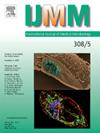重度宫颈坏死性筋膜炎中超病毒肺炎克雷伯菌 K16-ST660 的基因组分析和毒力评估
IF 3.6
3区 医学
Q1 MICROBIOLOGY
引用次数: 0
摘要
目的调查一名由肺炎克雷伯菌引起的反复严重颈部感染患者的感染源,并分析从患者不同部位分离到的菌株的毒力:我们收集了2017年至2018年期间两次到无锡市第二人民医院就诊的一名患者的术前颈部脓肿穿刺液、术中颈部引流液、痰液、肠道粪便标本和血液标本。我们对分离物进行了分离、鉴定、药敏试验和串联试验。使用 PCR 进行了胶囊血清分型和毒力基因分析。通过多焦点序列分型评估了不同分离株之间的遗传关系,并使用Galleria mellonella感染模型评估了毒力。此外,还利用全基因组测序分析了一个分离株的染色体和质粒基因:结果:在两次住院的痰液和粪便标本中,以及第一次住院的术前超声引导穿刺液和术中引流液中都检测到了肺炎克雷伯菌,共检出 6 个分离株。这些分离物均为 K16 血清型,串联检测呈阳性,经多聚焦序列分型鉴定为 ST660,表明它们属于同一克隆。病毒基因分析表明,wcaG、iucB、iroNB、rmpA、rmpA2、Aer、kfuBC、ureA、fimH、mrkD、uge 和 peg344 为阳性,而 allS、cf29a 和 Wzy_K1 为阴性。在黑线蝇毒力试验中,不同分离物的致死率呈剂量依赖性。与其他对照组(包括 K1、K2、K5、K20 和 K57 组)相比,K16 组的幼虫死亡率明显更高。基因组测序显示,质粒p17388携带大量毒力基因和插入序列,尤其是ISKPN74,并与其他克雷伯氏菌质粒表现出高度同源性:本研究首次报道了由 K16-ST660 肺炎克雷伯氏菌分离株引起的严重宫颈坏死性筋膜炎。Galleria mellonella 毒力测定和大量毒力基因的检测证实了这些分离株的高毒力。对质粒 p17388 的深入分析表明,ISKPN74 可通过重组酶和转座酶增强质粒与细菌染色体的稳定整合,从而降低质粒丢失的可能性并增强细菌的毒力。此外,IS5 家族的插入序列可能带有额外的启动子或增强子,当插入粘液相关基因(如 rmpA)的上游时,可提高下游基因的转录水平。这种由 ISKPN74 介导的整合或插入揭示了一种复杂的遗传机制,它可能会导致 ST660 分离物感染的严重程度。我们的发现为 ST660-K16 肺炎克雷伯氏菌的毒力和结构提供了新的见解,表明进一步研究这些插入序列增强毒力的具体机制有助于开发新型感染管理策略。本文章由计算机程序翻译,如有差异,请以英文原文为准。
Genomic Analysis and Virulence Assessment of Hypervirulent Klebsiella pneumoniae K16-ST660 in Severe Cervical Necrotizing Fasciitis
Objective
To investigate the source of infection in a patient with recurrent severe neck infections caused by Klebsiella pneumoniae and to analyze the virulence of isolates obtained from different sites of the patient.
Methods
We collected preoperative neck abscess puncture fluid, intraoperative neck drainage fluid, sputum, intestinal fecal specimens, and blood samples from a patient who visited Wuxi Second People's Hospital twice between 2017 and 2018. We conducted isolation, identification, drug sensitivity tests, and string tests on the isolates. Capsule serotyping and virulence gene analysis were performed using PCR. The genetic relationship of different isolates was assessed by Multilocus Sequence Typing and virulence was evaluated using the Galleria mellonella infection model. Additionally, whole-genome sequencing was used to analyze the chromosomal and plasmid genes of one isolate.
Results
Klebsiella pneumoniae was detected in the sputum and fecal specimens from both hospitalizations, as well as the preoperative ultrasound-guided puncture fluid and intraoperative drainage fluid from the first hospitalization, resulting in six isolates. These isolates were all K16 serotype, positive in the string test, and identified as ST660 by Multilocus Sequence Typing, indicating they belonged to the same clone. Virulence gene analysis showed that wcaG, iucB, iroNB, rmpA, rmpA2, Aer, kfuBC, ureA, fimH, mrkD, uge, and peg344 were positive, while allS, cf29a, and Wzy_K1 were negative. In the Galleria mellonella virulence assay, the lethality of different isolates was dose-dependent. The K16 group showed significantly higher larval mortality compared to other control groups (including K1, K2, K5, K20, and K57 groups). Genome sequencing revealed that plasmid p17388 carried numerous virulence genes and insertion sequences, particularly ISKPN74, and showed high homology with other Klebsiella plasmids.
Conclusion
This study is the first to report severe cervical necrotizing fasciitis caused by the K16-ST660 Klebsiella pneumoniae Isolate. The high virulence of these isolates was confirmed by the Galleria mellonella virulence assay and the detection of numerous virulence genes. In-depth analysis of plasmid p17388 suggests that ISKPN74 may enhance stable integration of the plasmid into the bacterial chromosome through recombinases and transposases, thereby reducing the likelihood of plasmid loss and increasing bacterial virulence. Additionally, IS5 family insertion sequences may carry extra promoters or enhancers that, when inserted upstream of mucoviscosity-associated genes such as rmpA, may increase the transcription levels of downstream genes. This ISKPN74-mediated integration or insertion reveals a complex genetic mechanism that may contribute to the severity of infections caused by ST660 isolates. Our findings offer new insights into the virulence and structure of ST660-K16 Klebsiella pneumoniae, suggesting that further investigation into the specific mechanisms by which these insertion sequences enhance virulence could aid in developing novel infection management strategies.
求助全文
通过发布文献求助,成功后即可免费获取论文全文。
去求助
来源期刊
CiteScore
9.70
自引率
0.00%
发文量
18
审稿时长
45 days
期刊介绍:
Pathogen genome sequencing projects have provided a wealth of data that need to be set in context to pathogenicity and the outcome of infections. In addition, the interplay between a pathogen and its host cell has become increasingly important to understand and interfere with diseases caused by microbial pathogens. IJMM meets these needs by focussing on genome and proteome analyses, studies dealing with the molecular mechanisms of pathogenicity and the evolution of pathogenic agents, the interactions between pathogens and host cells ("cellular microbiology"), and molecular epidemiology. To help the reader keeping up with the rapidly evolving new findings in the field of medical microbiology, IJMM publishes original articles, case studies and topical, state-of-the-art mini-reviews in a well balanced fashion. All articles are strictly peer-reviewed. Important topics are reinforced by 2 special issues per year dedicated to a particular theme. Finally, at irregular intervals, current opinions on recent or future developments in medical microbiology are presented in an editorial section.

 求助内容:
求助内容: 应助结果提醒方式:
应助结果提醒方式:


